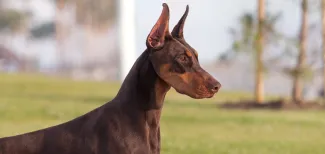DOWNLOAD PDF
A Doberman Pinscher named “Corie” has given her breeder-owner, Beverly Purswell, DVM, PhD, DACT, many reasons to be proud. For starters, Corie (GCH WR Encore Of The Danse v BJF CD OA OAJ LC-10L) has earned conformation and working titles. The 13-year-old black female also has qualified for a Longevity Certificate from the Doberman Pinscher Club of America’s (DPCA) Longevity Program.
Dr. Purswell, professor emeritus of large animal clinical sciences at Virginia-Maryland College of Veterinary Medicine and health education coordinator for DPCA, says, “The Longevity Program is a great way to keep up with dogs that live into double digits. Striving for longevity in our Doberman Pinschers is so important. Some of the worst health conditions in the breed have no genetic tests. Sadly, many beloved dogs don’t live long enough to qualify for the Longevity Program.”
Breeding Corie to a Longevity Certificate male, CH Irongate’s Winter Knight CD ROM LC-10D, qualified the litter for Bred for Longevity certification (BFL). The female puppy whom Dr. Purswell kept, “Favor” (CH WR Fait Accompli v BJF BFL-1), is now 9 1/2 years old. On her birthday in 2022, she, too, will qualify for a Longevity Certificate.
The Longevity Program is open to Doberman Pinschers 10 years of age or older or those with parents that have lived to 10 years of age or older. Since the program began in 1997, the Longevity Program has certified over 4,500 Doberman Pinschers for longevity, over 1,000 for Bred for Longevity-1 (BFL-1), and over 75 for Bred for Longevity-2 (BFL-2), says Michelle Kramer, chair of the Longevity Program.
Doberman Pinschers were the 18th most popular breed registered with the American Kennel Club (AKC) in 2020, with 9,778 dogs registered. Roughly 0.5 percent of registered Doberman are longevity certified, Kramer says.
“The goal of this program is to recognize and track breeders who are breeding Doberman Pinschers that are long-lived,” says Kramer. “In recognizing them, we can help people who are looking for puppies because they can search the online database to find breeders who focus on longevity in their breeding programs.”
The late Vic Monteleon of San Diego, past president of DPCA, founded the Longevity Program to identify dogs and lines with strong longevity. It was approved unanimously at the 1997 DPCA National Specialty in Houston.
To be eligible, dogs must be registered with the AKC or a respective international breed registry. About 300 Dobermans in the program are from international countries. Dobermans must be of an approved coat color to be eligible; those with the Z-factor gene variant that causes albinism are not eligible. A breeder or owner can apply for certification for individual dogs.
Dogs accepted into the program are entered in the online Longevity Program database, DobeQuest. The real-time database allows owners to regularly update information about their dogs and to include photos, earned titles, and health testing information.
Here is how the Longevity Program works:
- Longevity Certification (LC): Doberman Pinschers that reach age 10 may receive LC recognition. Dogs are issued a certificate such as LC-10L, which designates their age of 10 and “living” status. When a dog dies, owners are encouraged to notify the program, so the online database can be updated and a final certificate can be issued with the age at death and the ending changed to D for “deceased.” Ideally, owners will provide a presumed cause of death. Dogs also can be submitted for recognition posthumously even if they passed away many years ago.
- Bred for Longevity (BFL-1 and BFL-2): Doberman Pinschers of any age whose sire and dam are longevity certified (LC), or lived to at least 10 years of age, are eligible for BFL-1 recognition. Those whose sire and dam as well as all four grandparents lived to 10 years old are eligible for BFL-2 certification.
Efforts to encourage new members of DPCA, specifically those wanting to better the breed, led to DPCA organizing
the Generation Forward committee in 2015. More recently, the committee added a mentorship program to help those interested in breeding who want to learn more, says chair Theresa Connors-Chan.
“Our goals are to encourage the sharing of knowledge and to support new breeders, members, exhibitors, and competitors,” Connors-Chan says. “We have 38 mentors who are matched with mentees based on their individual goals. The program provides one-on-one support as well as webinar and seminar education.”
Veteran breeder Colleen Nicholson of Mechanicsburg, Pennsylvania, is a mentor to those who are new in the breed. “For starters, I advise breeders to health test any dogs they are considering breeding using the recommended OFA CHIC (Orthopedic Foundation for Animals’ Canine Health Information Center) requirements,” she says. “The Longevity Program has gifted us with another tool to use to help determine the best stud dogs for bitches.”
“Longevity Certificates and Bred for Longevity certificates are valuable for people researching pedigrees because it shows the longevity behind a dog,” says Connors-Chan. “The Longevity Program also gets people involved in studying pedigrees to understand health concerns in bloodlines.”
As Kramer says, “Many breeders try their hardest to breed healthy, long-lived Dobermans. Together, we can do our best to ensure Dobermans are a healthy breed.”

